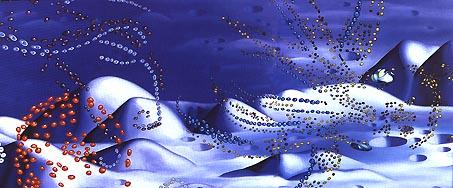
Kraken, 1997, Öl auf holz, 232 x 383 cm, detail

(...) Our eyes are wide open in our contemporary awareness of life. They let in every one of the countless images that are constantly available from all directions. Scanners for the image of the world, instruments that are permanently set to receive. But if all they do is merely register, then our curiosity tends to diminish. The pos-sible ways of creating images, of conveying and recording them, have been greatly extended and accelerated, but not much headway has yet been made in terms of the symbolic process, the ability and will to give meaning to visual data. And the paintings from Corinne Wasmuht are also part of the flo-od of
visual information. But this flood is not accepted as a mere fact, where
all that is needed is to learn how to allow oneself to be swept along by
it skilfully. When certain subjects are involved the contrary is the case,
and then the material is tested for complexity and possible meaning, using
processes that are constantly renewed. And so we are not recording a stream
of images, but acquiring our own image cosmos. But that is done by using
the resources of painting, the resources of a traditional, disciplined way
of painting that comes from a quite different time and that seems to be
obsolete. A contemporary experience of life, determined by advanced technology
is - in a way that seems paradoxical at first - processed by an instru-ment
that is from:Julian Heynen, Augen-Puls, in: Wasmuht-Gerwers-Skreber, ars viva 96/97 Malerei, pub. by the Kulturkreis der deutschen Wirtschaft im BDI e.V., Cologne 1996, pp. 9-11.. Photo: |